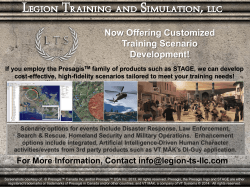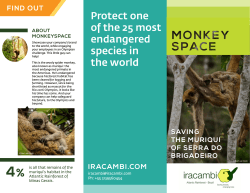
Endangered Animals
Teacher: Marrita Osbourne Grade Level: 4-5 Subject Area: Science Content Focus: Endangered Animals Enrollment: 20 Time: 45 minutes Religion: N/A Sex: 12 girls and 8 boys 1. Relevant State and National Content Standards: 3.2 Understand that organisms can survive and reproduce only in environments that meet their basic needs. 4.2 Know that all organisms depend on the living and non-living features of the environment for survival. 2. Learners’ Background The students are all avid readers who are aware that animals that use to exist millions of years ago have ceased to exist now. They know that extinction does not happen over night it is a slow process. All of the students are interested in animals and in a previous lesson they wrote about any animal they would like to have as a pet. This is a diverse class and some of the endangered animals come from the countries that these students are from. 3. Student Learning Objective The student will be able to: a. Define endangered animal. b. Develop a list of possible reasons why animals become endangered. c. Define the acronym HIPPO. d. Sort various endangered scenarios into different categories. e. Name 5 endangered animals. 4. Materials & Teacher-developed Resources a. Paper b. Pencil c. Erasers d. Scenario cards with sentences 5. Learning Activities (Teaching and Learning Strategies with an Approximate Timeline) Initiation I. Show students 4 pictures of endangered animals (cheetah, tapir, blue whale, and panda) then ask them what common problem these animals share? II. Ask students to define endanger. Endangered – Animals or plants whose numbers are so few they are in danger of becoming extinct. III. Ask two students if they know any other animals that are endangered. IV. Write student-friendly objective on the board “We will sort various scenarios into categories to discover the main reasons animals become endangered.” 1 Development I. Discuss as a class why animals become endangered. Reasons include: 1. Chopping down trees 2. Too many cars 3. Killing animals for fur 4. Bring animal into a new place 5. Humans need more space to create roads, buildings, etc. 6. Parasites and diseases 7. Natural causes 8. Fires 9. Loss of main prey II. Introduce students to the acronym HIPPO H – Habitat loss I – Introduction of new species P – Pollution P – Population growth O – Overconsumption of animals Reason Example Habitat loss Chopping down rainforests Introduction of new species Bringing a non-native (new) species to a habitat Pollution Oil spills, garbage in ocean, car emissions Population growth Human population is growing which means more space is needed to cater for the growth Overconsumption of animals Killing animals for fur III. Put students in groups of 4 to sort scenarios into the HIPPO categories. There will be at least 5 scenarios for each group to sort out. Group 1 – Scenario 1, 2, 4, 5, 14 Group 2 – Scenario 3, 6, 7, 8, 13 Group 3 – Scenario 9, 10, 12, 13, 2 Group 4 – Scenario 11, 14, 1, 3, 5 IV. Students will fill out worksheet, writing the name of the animal and completing the sentence “This animal is endangered because…” (Please see attached sheet—page 9—for Scenarios 1-14) V. After scenarios have been sorted, bring the whole class back together. Closure I. Bring students back together II. Acronym to remember the most common reasons why animals are endangered is: HIPPO. III. Example of endangered animals: Amsterdam Albertross – endangered because new species were introduced in their habitat. Orangutans – endangered because of habitat loss. 2 Homework Think of an animal that is endangered and write a scenario, using HIPPO about that animal. 6. Evaluation of Student Learning Informal assessment: Walk around class and visit each group to observe if they are on task and they are doing the assignment correctly. Formal assessment: What is endangered animal? Reason why animals become endangered? What is the acronym to remember the main reasons why animals become endangered? Ask 3 or 4 to give a scenario for each of the five causes of extinction (HIPPO) 7. Modifications for Individuals Needing Differentiated Instruction Student Name Jenny Blake Evidence that the student needs differentiated instruction Jenny is an ESL student who recently moved from Bangladesh. How will you differentiate instruction in this lesson to support student learning? I will differentiate this lesson by adding pictures to the scenario cards. For example, a scenario card that reads: I am hunted for my skin and meat. Above that written scenario I would add 3 different pictures, the first picture would be of a specific endangered animal (there would be 4 drawings of that animal), the second picture would be of a hunter and the last picture would be of those 4 animals again but with an X through about 2 of 4 of them. In addition, when giving instructions I would speak slower and clearer to this student using simple language. Finally, I find that grouping this student with a patient and socially conscious student is very helpful. 3 Jon Richards Jerry Brandford Jon is blind. Jerry has been diagnosed with ADHD and takes medications 2 times day. I will differentiate this lesson by recording the scenarios on a tape. For example, “Scenario 8, Tapir, I am hunted for my skin and meat.” I would then play the tape in a tape recorder for the student. The student would also be able to record their answers on a separate recorder, by simply stating the Scenario number, the animal and by finishing the sentence “This animal is endangered because…” For example, “Scenario 8, Tapir, This animal is endangered because of overconsumption.” I will differentiate this lesson by using the student’s interest to keep him focused. Jerry enjoys art so I would have him color the pictures of the animals along with drawing one of the animals on a scenario sheet. When giving verbal instructions I will maintain eye contact with the student, making directions clear and concise. Also, I will simplify complex directions and avoid multiple commands. 8. Teacher Reflection I would like to have a better “hook” for the opening of this lesson in order to get the students more captivated. There is definitely room for improvement with this lesson plan. For example, I could separate the groups to focus on endangered birds, endangered plants and endangered animals. The next time I do this lesson I will make sure that I display numerous books about endangered animals. For example, book such as, Turtles and Scholastic Q & A: Where Have All the Pandas Gone? Another improvement to this plan is to have bigger cards for the scenarios so that I can add a small fact on them about the animals and the countries where they can be found. I believe the lesson was successful because of the high level of participation during the informal assessment. 4 Name Date Please complete the chart below with the name of the animal and the scenario number in the left column and the reason why the animal is endangered in the right column. H – Habitat loss I – Introduced of new species P – Pollution P – Population growth O – Overconsumption of animals Endangered animal (Scenario) This animal is endangered because… 5 Scenario 1 Scenario 2 Introduced cattle and cats have damaged my nesting site on the small island where I live. Amsterdam Albatross I live in rainforests, which are now being rapidly cut down for wood and farming. Orangutans Scenario 3 In 1963, the shortfin mollie, a non-native fish caused a rapid decline in my population. Moapa Dace Scenario 5 Scenario 4 During oil spills the oil enter my lungs and sometimes my blowhole. Blue whale Poachers kill me or leave me without protection and use my horns for many different things. White rhinoceros Scenario 6 Scenario 7 Scenario 8 The eucalyptus leaves are my main food and they are becoming inedible because of global warming. Koalas I am hunted for my skin and meat. Malayan Tapir As the human population grew they began to use my forest for agriculture. Purple Marsh Crab 6 Scenario 9 Scenario 10 My habitat is being destroyed as plantations are converted into tourist destinations. Rameshwaram parachute spider Predation of my eggs and young ones by the introduced bush pig is one of my main threats. Ploughshare Tortoise Scenario 11 Scenario 12 I don’t have any bamboo to eat because the bamboo forests are cleared being away. Giant Pandas My species is decline rapidly due to collecting and shooting. Whooping crane Scenario 13 Scenario 14 The growth of cities is one of the causes of my endangerment. Ocelots The shortgrass prairie that I live in continues to be plowed up for crops. Black-footed Ferret 7 7. Modifications for Individuals Needing Differentiated Instruction Possible example of ESL student scenario card: Scenario 7 I am hunted for my skin and meat. Malayan Tapir
© Copyright 2025









